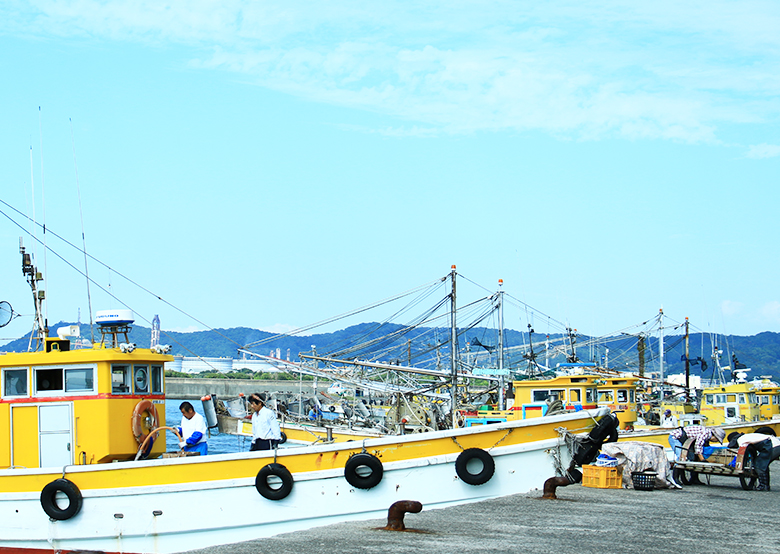

Open 9 am to 6 pm
Closed Wednesday
*Dining hall open from 10 am
*Do not enter this number in your car navigation system


Arida City is located in the northwestern part of Wakayama Prefecture facing the Kii Channel. Due to the influence of the inland sea water from Osaka Bay and the Kuroshio tributary from the south, it is a place with abundant marine resources and a thriving coastal fishery.
There are five fishery cooperatives, Minoshima Fisheries Cooperative, Hatsushima Fisheries Cooperative, Oui Fisheries Cooperative, Chida Fisheries Cooperative, and Kita Minoshima Fisheries Cooperative. They merged on October 1, 2008 to become "Arida Minoshima Fisheries Cooperative".
In the Minoshima Fisheries Cooperative / Tatsugahama area, the fishing ships leave the port at around 3:00 am and return at around 3:00 pm same day. Many hand carts line up at the fishing port to carry the caught fish and in no time at all the port overflows with life.
| Name | Arida Minoshima Fisheries Cooperative |
|---|---|
| Address | Miyazaki-cho 2405, Arida City 649-0316, Wakayama Prefecture |
| TEL | +81-737-83-5555 |
| FAX | +81-737-82-1512 |
| jfm@pure.ocn.ne.jp | |
| Business Hours | Open from 8:30 am to 12:00 pm and 1:30 pm to 5:00 pm on Weekdays *These are NOT the business hours for Hama no Utase |

This method of small-scale ship, bottom trawling fishing has been called "Utase" for a long time, mainly in the Tatsugahama area. The ships depart from the fishing port at around 3:00 am on operating days.
The main fishing areas are mostly on the coast of Wakayama Prefecture in the Kii Channel, and sometimes far off the coast of Shirahama Town. Catches include hairtail fish, shrimp, and red sea-bream. The ships return to the port at around 4 pm same day.
The method of catching the fish is to throw a bag-shaped net from the stern, pull it along the bottom of the sea for about 2 hours, and then pull up the net. This net has an opening plate that widens the mouth of the net and is devised so that many fish can enter the net.



This method of small-scale ship, bottom trawling fishing has been called "Utase" for a long time, mainly in the Tatsugahama area. The ships depart from the fishing port at around 3:00 am on operating days.
The main fishing areas are mostly on the coast of Wakayama Prefecture in the Kii Channel, and sometimes far off the coast of Shirahama Town. Catches include hairtail fish, shrimp, and red sea-bream. The ships return to the port at around 4 pm same day.



Fishing in the Seto Inland Sea using ship-pulled seine nets is also locally called “patchi” net fishing, where two ships pull nets shaped like patchi (long-johns). It is a fishing method used to catch whitebait and squid roaming the upper part of the sea.
For this fishing method, in addition to the two fishing boats drawing nets, there are two other fishing boats, one is a fish finder that uses a fish detector to search for whitebait and the other boat immediately transports the caught fish to the whitebait processing plant on land. These four boats form one fleet.



Fixed-net fishing is a fishing method in which a large net reaching from the surface of the water to the bottom of the sea is stretched about 800 meters straight from the shore to a position offshore, and the fish that encounter it are guided into the net to be caught.
Every spring, red sea-bream and other fish move from deep to shallow waters to spawn, the routes these fish take are fixed and are so called “fishways”. In addition, the fish have a habit of escaping deeper when they encounter obstacles. Because of this, fish that encounter a large net continuing from the shore will naturally enter the maze of the net below and will not be able to exit so we can catch them.



The rod-and-line fishing is a method in which a fishing boat goes offshore and catches fish one by one using fishing lines and hooks, and the main fish species are horse mackerel (Aji), mackerel (Saba), and Spanish mackerel (Sawara). Anyone can do this kind of fishing.

